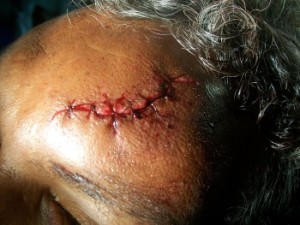Quick and Easy Assessment of the Head Injured Patient: Part 1- The Adult Population
 There are many things that go into assessment of the head injured patient who presents to the emergency department. Here’s what emergency department nurses are expected to look for in the proper assessment of an adult head injured patient. These tips will help you as a legal nurse consultant review the emergency department record of a patient who has fallen.
There are many things that go into assessment of the head injured patient who presents to the emergency department. Here’s what emergency department nurses are expected to look for in the proper assessment of an adult head injured patient. These tips will help you as a legal nurse consultant review the emergency department record of a patient who has fallen.
Harriet Rogers arrives from Always the Best Nursing Home. She has a large profusely bleeding laceration over her right eye.
The assessment of the head injured patient involves first getting the story
First, the triage nurse has a relatively short time to get the story of why the patient came into the emergency department. In those few minutes, the nurse needs to use all of his or her senses to obtain the needs of the patient, the possible situation, and the number of resources that the patient will require while in the emergency department.
The triage nurse asks the nursing home staffer what happened. He hears, “I don’t know. We found her on the floor of the recreation room.”
Assess the patient
Second, the nurse needs to take a good look at the patient. How old is she? The elderly have a higher probability of an intracranial bleed due to co-morbidities and possible anticoagulant therapy (Inui, T., 2014).
Suppose your assessment of the head injured patient shows she is on anticoagulation therapy. This is considered a level 2 on the ESI (emergency severity index with 5 needing no resources, a minor complaint, to a level 1, needing lifesaving intervention).
The nurse needs to see if the patient is incontinent of bowel or bladder, if she has any additional wounds besides the head laceration, or if she is oriented to person, place, and time.
The nurse asks, “Where are you? What is your name? What day is it?” Harriet mumbles incoherently in response.
The standard of care requires the ED nurse to ask the nursing home staff about Harriet’s baseline mental status information, along with the last time she was seen as “normal” prior to the fall. The nurse should always consider placing the patient in a hard cervical collar and possibly a backboard if any neck or spine injury is suspected with along with the head injury.
Determine the Mechanism of Injury in the Assessment of the Head Injured Patient
Thirdly, the nurse needs to get the mechanism of injury facts. If the patient fell off of an object, such as a bed, how high up was she? If the patient stated she fell from a standing position, did she trip over an object? If she felt dizzy prior to the fall, this could indicate a cardiac or brain event. If she did not block her fall with her hands, it could mean she had a sudden loss of consciousness, also indicative of a cardiac event.
If her fall was witnessed, the triage nurse should get the witness’ explanation (if available) on what happened before, during, and after the fall. The witness could provide valuable information such as a mental status baseline of the patient or if the patient had seizure activity after the fall. If the head injured patient was discovered on the floor (unwitnessed fall) with an unknown amount of time elapsed, this could also indicate a serious medical issue for this patient.
The ED nurse asks the nursing home staffer: “What was the floor surface in the recreation room? When was Harriet last seen? Do you have any idea how long she was on the floor?”
The scenarios that cause a head injured patient to be brought to the emergency department are as varied as the number of patients that come through the emergency department on a daily basis. The emergency treatment of these patients must include delivering a standard of care that incorporates the nurse’s experience, clinical knowledge, and assessment skills.
By using the information provided here, the legal nurse consultant can review an emergency department medical record for a head injured patient and look for key pieces of information.

Veronica Manlove
Veronica shares her expertise with you in our all new Falls Course Get all the details of this on demand here.
Reference:
Inui, T. S., Parina, R., Chang, D. C., Inui, T. S., & Coimbra, R. (2014). Mortality after ground-level fall in the elderly patient taking oral anticoagulation for atrial fibrillation/flutter: A long-term analysis of risk versus benefit. Journal of trauma and acute care surgery, 76(3), 642-650.
